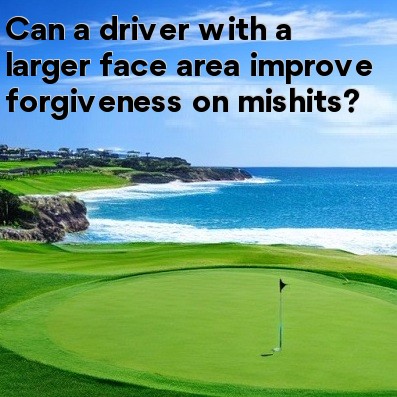
In golf, Can a driver with a larger face area improve forgiveness on mishits?
One of the key factors in hitting a long and accurate drive in golf is making solid contact with the ball. A mishit, where the ball is struck off the center of the clubface, can result in a loss of distance and accuracy. To combat this, golf club manufacturers have introduced drivers with larger face areas, claiming to improve forgiveness on mishits. But does a larger face area really make a difference?
Understanding the concept of forgiveness
In golf, forgiveness refers to the ability of a club to reduce the negative effects of an off-center strike. When a golf ball is hit off the center of the clubface, it can lead to a loss of distance, accuracy, and control. A driver with greater forgiveness will minimize these negative effects, allowing golfers to achieve better results even on mishits.
The relationship between face area and forgiveness
The face area of a golf driver refers to the part of the clubhead that comes into contact with the ball during impact. A larger face area means there is more surface area available for contact, increasing the likelihood of hitting the ball on or near the sweet spot – the center of the clubface. This, in turn, can improve forgiveness on mishits.
The benefits of a larger face area
- Expanded sweet spot: A driver with a larger face area provides a bigger sweet spot, which means that even off-center strikes have a higher chance of achieving better distance and accuracy. This is particularly beneficial for amateur golfers who may struggle with consistent ball-striking.
- Enhanced stability: The larger face area also increases the MOI (moment of inertia) of the clubhead. This results in better stability throughout the swing and at impact, reducing the club's tendency to twist or rotate on off-center hits. This stability translates into more consistent and predictable ball flight.
- Improved confidence: Golfers who use drivers with larger face areas often report feeling more confident during their swings. The knowledge that mishits will be more forgiving can give golfers the freedom to swing more aggressively, resulting in increased swing speed and potentially more distance.
The limitations of a larger face area
While a larger face area can certainly improve forgiveness on mishits, it is essential to understand that it is not a magic solution to all golfing woes. There are other factors, such as swing mechanics and clubhead design, that also contribute to forgiveness. Furthermore, some golfers may prefer the feel and aesthetics of a smaller clubhead, regardless of the potential forgiveness benefits of a larger face area.
Choosing the right driver
When selecting a driver, forgiveness should be one of the factors considered. However, it is crucial to strike a balance between forgiveness and other aspects such as distance, accuracy, and personal preference. Trying out different drivers with varying face sizes and seeking professional club fitting advice can help golfers find the ideal club for their individual needs.
In conclusion
A driver with a larger face area can indeed improve forgiveness on mishits. The expanded sweet spot, enhanced stability, and improved confidence are all significant benefits. However, it is crucial to remember that forgiveness is not solely reliant on face area, but also on other factors, such as swing mechanics and clubhead design. Ultimately, finding the right driver requires a combination of understanding one's own game and seeking professional advice.





